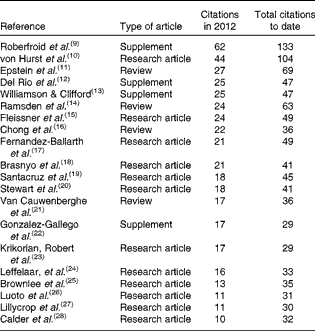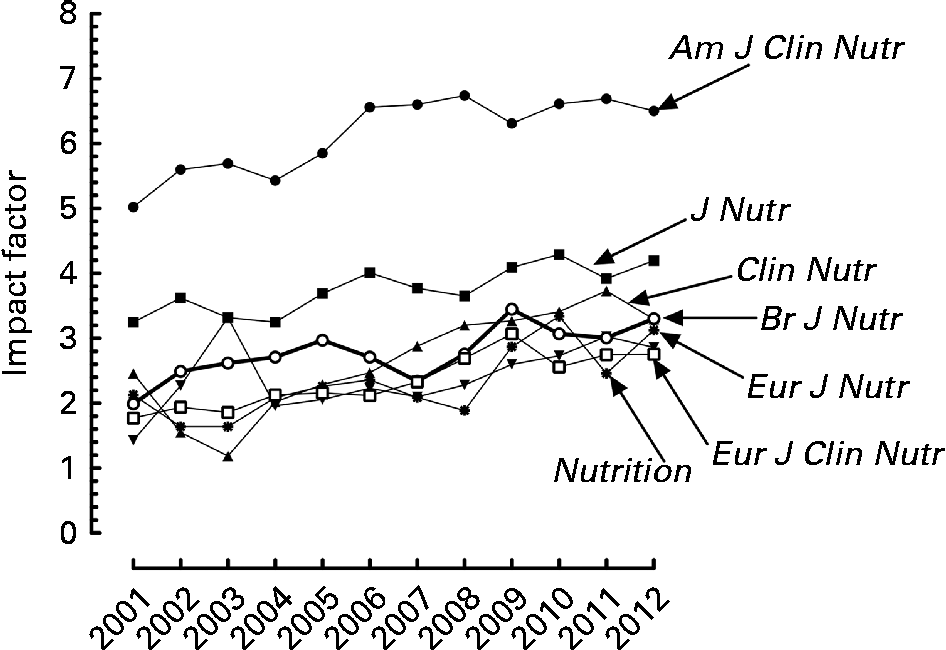In June 2013, the Institute for Scientific Information (ISI) released its annual assessment of the citation of articles published in scientific journals. These metrics provide valuable insights into the performance of journals both individually and in relation to others publishing similar content in the same field. In order to inform readers about the performance of the British Journal of Nutrition (BJN) over the preceding 12 months, I plan to follow the precedent set by my predecessor in writing an annual editorial to review the state of the journal( Reference Calder 1 – Reference Calder 8 ).
This editorial is based on data collected from the ISI Journal Citation Reports® database, in which the BJN is listed under the Nutrition and Dietetics category. The information presented in Tables 1 and 2, and in Fig. 1 was obtained from online searches of the ISI database on 18 July 2013. There are currently seventy-six journals listed under the Nutrition and Dietetics category, which encompass a wide range of specialities within this field. This category includes journals that publish only reviews or reports of primary research, while others publish a range of types of articles. BJN falls into the third group, and I have selected six journals with similar content and status for comparison. These are listed in Table 1.
Table 1 Selected publication metrics of the British Journal of Nutrition (Br J Nutr) and of comparator journals in 2011 and 2012*

Am J Clin Nutr, American Journal of Clinical Nutrition; Clin Nutr, Clinical Nutrition; Eur J Clin Nutr, European Journal of Clinical Nutrition; Eur J Nutr, European Journal of Nutrition; J Nutr, Journal of Nutrition.
* Data were obtained from the Institute for Scientific Information Journal Citation Reports® database.
† Ranking among the journals in the Nutrition and Dietetics category.
Table 2 Articles published in the British Journal of Nutrition in 2010 and 2011 that were most highly cited in 2012*

* Data were obtained from the Institute for Scientific Information Web of Science® database on 18 July 2013.

Fig. 1 Year-on-year impact factors of the British Journal of Nutrition (Br J Nutr) and of comparator journals. Am J Clin Nutr, American Journal of Clinical Nutrition; Clin Nutr, Clinical Nutrition; Eur J Nutr, European Journal of Nutrition; Eur J Clin Nutr, European Journal of Clinical Nutrition.
The impact factor is perhaps the most widely used metric for assessing the citation of articles published in journals. The pros and cons of using the impact factor to assess the performance of a journal have been discussed in a previous editorial( Reference Calder 7 ). The impact factor of a journal is calculated by dividing the total number of citations of papers published in the previous 2 years by the number of papers that the journal has published over these periods. The impact factor of the BJN for 2012 (issued in 2013) is 3·3 (Table 1), which is the second highest score for this journal in the past 10 years (the highest was 3·45 in 2009) (Fig. 1). This represents an increase of 9·6 % in 2012 compared with 2011 (Table 1) and an overall increase of 33 % compared with 2002 (2·49) (Fig. 1). The number of citations of articles in 2012 was a new record for the BJN (Table 1), an increase of 12·8 % compared with 2011 and a 2·7-fold more citations than in 2002 (6205) (Fig. 1). The 5-year impact factor of the BJN also increased between 2011 and 2012 (Table 1). As a consequence of the increased citation of articles published in the journal, the rank position of the BJN in the Nutrition and Dietetics category increased from 19/72 in 2011 to 18/76 in 2012. The number of manuscripts submitted to the BJN increased steadily between 2001 and 2009, but then rose markedly between 2009 and 2010 (Fig. 2). However, the number of articles submitted has remained essentially the same at approximately 1400 per year since 2011 (Fig. 2). Currently, approximately 30 % of manuscripts submitted to the BJN are accepted for publication. Together, these performance indicators show that BJN is maintaining a sustained, steady increase in both citations and impact.

Fig. 2 Year-on-year number of manuscripts submitted to the British Journal of Nutrition.
The selected comparator journals had mixed fortunes in 2012. Of these, the American Journal of Clinical Nutrition continued to receive the highest impact factor (6·5), although slightly lower than in 2011, and remained ranked 3rd of all journals in the Nutrition and Dietetics category (Fig. 1; Table 1). The impact factors of Clinical Nutrition and Nutrition also fell in 2012 compared with 2011, accompanied by lower rank positions (Table 1). In contrast, the impact factors of the European Journal of Clinical Nutrition (Eur J Clin Nutr), the European Journal of Nutrition (Eur J Nutr) and the Journal of Nutrition (J Nutr) increased between 2011 and 2012. For the Eur J Clin Nutr and the Eur J Nutr, the increase in the impact factor was accompanied by an increase in their ranking, while the rank position of J Nutr (10/76) was unchanged in 2012 compared with 2011 (Table 1). Overall, the performance of the BJN in 2012 was among the best-performing journals of its type in the Nutrition and Dietetics category.
As in 2011( Reference Calder 8 ), the most highly cited articles in the BJN in 2012 were predominately papers reporting primary research findings (Table 2). However, the most highly cited article in 2012 was a review by Roberfroid et al. ( Reference Roberfroid, Gibson and Hoyles 9 ) on the potential health and metabolic benefits of probiotics published in a supplementary edition of the BJN. Review articles also made an important contribution to the most citied articles in 2012, although the number of review articles in the top twenty most citied articles in 2012 was less than that in 2011( Reference Calder 8 ).
Overall, BJN is continuing to perform at least as well as the best journals publishing a similar range of articles in the Nutrition and Dietetics category. The high number of manuscript submissions and increasing citations suggests to me that BJN is well respected among researchers in the field as a source of high-quality publications in nutritional science. Nevertheless, I am convinced that BJN has not yet achieved its full potential and that continued improvement in its impact factor and in other measures of performance will enhance the (perceived) quality of the journal and secure the place of BJN among the best journals in the field of nutritional science.





